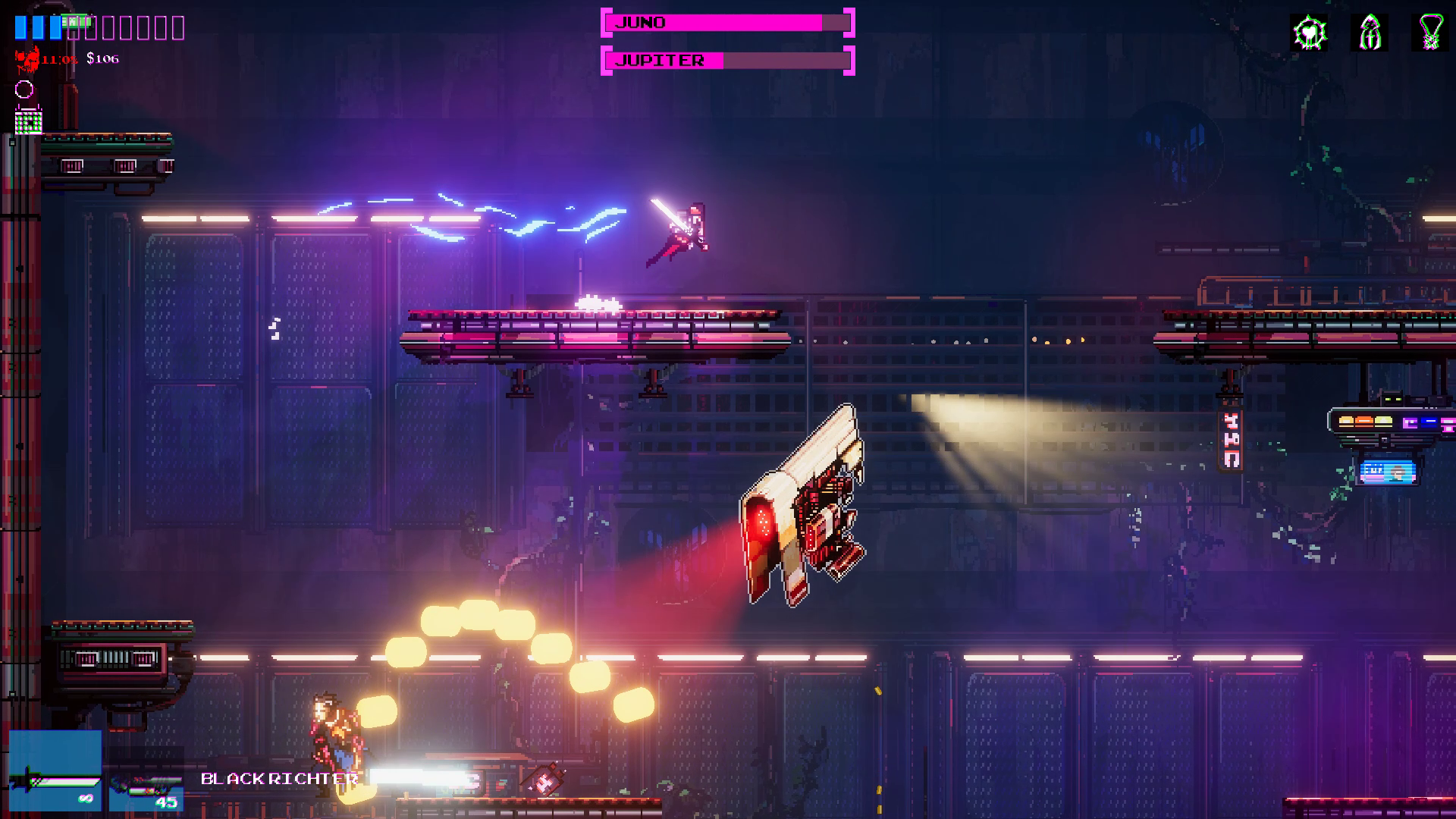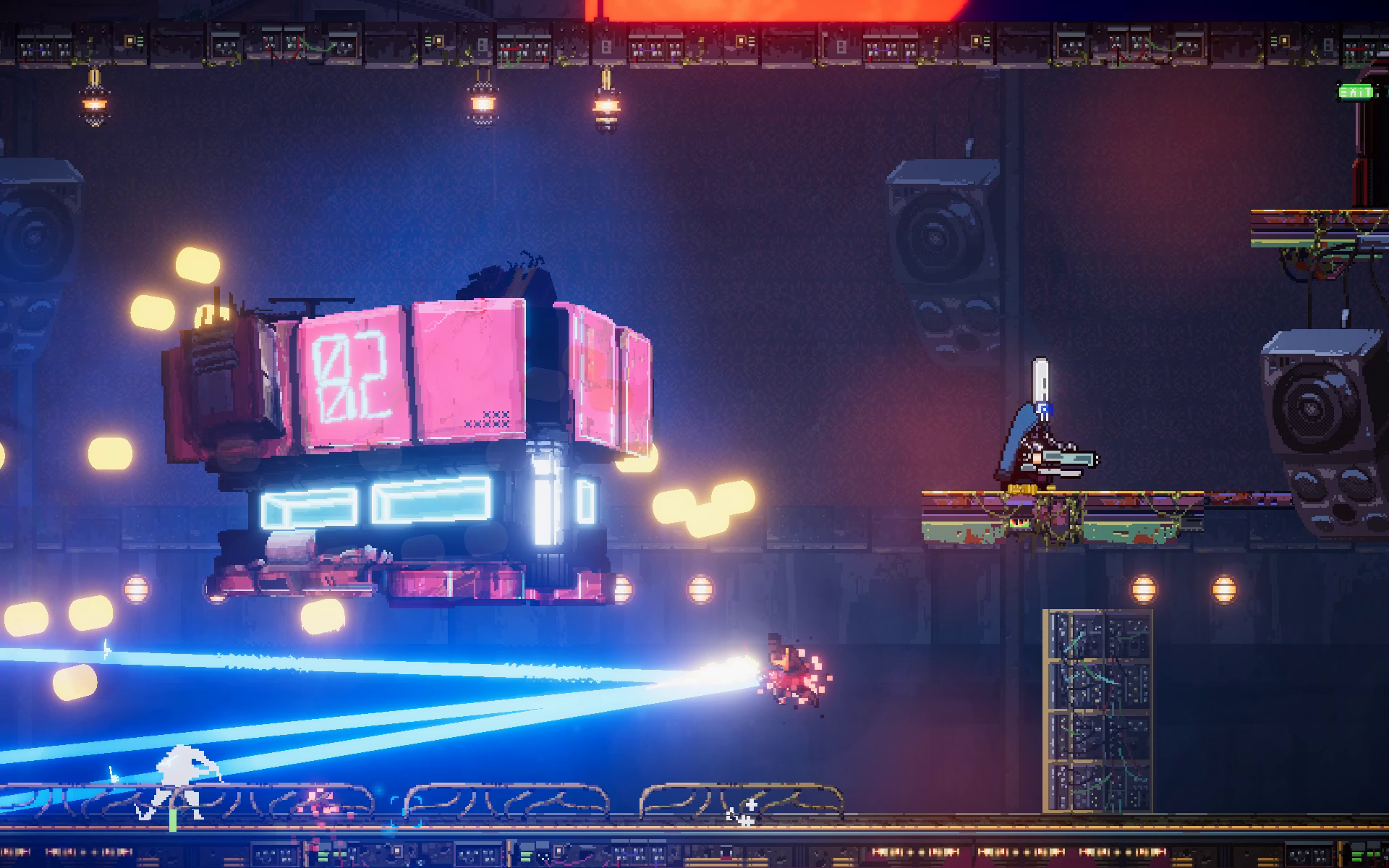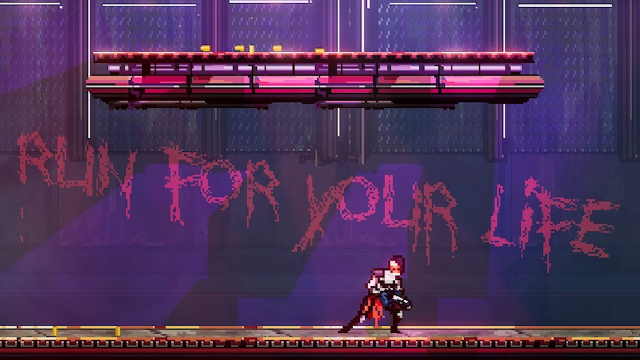At first glance, the PC game Black Future ’88 looks like too many other indie games, with its pixel art, synth music, and neon-infused cyberpunk aesthetic. But below the familiar surface is a well-defined roguelike with a surprisingly distinct identity forged in large part by the sheer force of creative will imposed by its maker, Don Bellenger.
“The tower’s alive,” Bellenger told me breathlessly when I first picked up the game, which is coming out sometime later this year, last week at E3 2018. Bellenger hopes that each playthrough of Black Future, a roguelike where you fight your way up multiple floors of a tower, will tell its own story. That’s not surprising, given how many stories Bellenger himself has to tell.
“I took a break from gaming after burning out really hard during the MOBA wars where everybody fought and everybody lost,” Bellenger told Kotaku at the show. In early 2015, Bellenger was a lead engineer at the San Francisco game studio Kixeye, working on Tome: Immortal Arena, a multiplayer online battle arena game designed to be played in short bursts on web browsers.
For a time, following the success of League of Legends in 2009 and Dota 2 in 2013, MOBAs were seen as the next big game genre companies could cash in on, similar to the current Battle Royale bubble. While those two behemoths have stuck around and maintained their popularity, there’s a long list of also-rans that fizzled out. Tome, a more agile attempt with more frenetic, streamlined gameplay designed for a quick match during a lunch break, was just one of the many casualties.
Changes with Google Chrome ended up making its browser interface no longer feasible, and the game had to pivot to Steam, a platform for which it was ill-suited and from which it quickly disappeared from view. Even Bruce Campbell calling plays as the in-game announcer couldn’t save it.

“I killed myself for three years and then it got canceled six weeks after it launched,” said Bellenger. He wasn’t happy with what he described as a fractious, competitive work culture at Kixeye, a company that has had more than its fair share of workplace toxicity in the past. He left after Tome‘s implosing and went into working on financial software.
In his free time, Bellenger played synth-punk at local clubs and eventually got it into his head to make a video game soundtrack. “I just think there is a better music market in video games than the music industry proper,” he said. Not soon after, the action-platformer prototype that would become Black Future ’88 was born, a project he’s been working on since May of 2016 with the help of a handful of part-time people including pixel artist Zac Bolubasz.
What Bellenger learned working on a cookie-cutter MOBA at Kixeye ended up forming the DNA for the indie game that would finally allow him to express his own interests and style. “I got to work with some really good engineers from Blizzard that worked on StarCraft and StarCraft 2,” he said of his time helping to develop Tome. “The backbone of Black Future is really a MOBA backbone.”
There are 350 abilities in the game, as well as unique weapons and death conditions. “It’s actually architected exactly like the MOBA I worked on. I could not have made this game without that [experience].”
Free of the constraints of working for a company, Bellenger is able to take what he learned and apply it to the things he loves, namely synth music and 80s cinema. Cultural and aesthetic touchstones for the game include Robocop, Depeche Mode, and more obscure influences like the Nebraska-based dance-punk band The Faint.
“Listening to [The Faint] was the first time I realised you can really fuck up a synthesiser and it actually sounds better,” he said. “It was kind of this Jimi Hendrix moment for me, realising you could really abuse an instrument and get something really nice out of it.”
While the gameplay is informed by MOBAs, Black Future ’88‘s structure is based off the soundtrack Bellenger composed for it, with different songs for each of the levels and bosses named after various synthesiser instruments. The process, he said, has been one of trying to create music and then fit the game around it until they’re both resonating at a similar frequency, evoking a feeling that’s more gothic punk than Blade Runner ripoff.
There’s a sort of devil-may care attitude present in the game that feels more rebellious in the punk rock kind of way than the rogue film noir detective. Part of that is the nihilism. The aim of the game is to defeat the tower in under 18 minutes, with extra time being added for making progress quickly.
You can dodge through walls, upgrade weapons from special enemies the tower spawns to hunt you, and even use various drugs to get status buffs in exchange for becoming addicted and being made extremely vulnerable to enemy attacks. The game encourages players to embrace the chaos and hope they come out on the other side, rather than play it safe and run out of time.
It’s a true roguelike, so money and upgrades don’t carry over between playthroughs, but the more you play, the more stuff gets unlocked that can spawn on subsequent attempts, similar to The Binding of Isaac.

While there is a co-op mode, I found from the demo that Black Future ’88 can be so hectic at times playing with another person feels more akin to being in a moshpit than part of a carefully synergized team. One cool thing it does have that other co-op roguelikes don’t is the ability to take allies who have fallen in battle and upload their brain scans to a unique repairable drone character that appears on later levels and is the only one who can fly, a particularly morbid twist on bringing teammates back from the dead that plays into the game’s overall grim vibe.
Bellenger himself exudes everything but that, however. At one point in our conversation he cavalierly told me about the time he ran away from school while studying abroad in New Zealand. Hitchhiking across the country he did a stint working on an organic farm but told me he eventually left, afraid the farm owner’s jealous boyfriend might try to kill him.
“I literally stepped into the night like I’m so afraid of everyone,” he said. Running away again, he got picked up by a group of women driving an ambulance converted into a mobile sound system. “It was just like a stereo on wheels, there were amplifiers and speakers and subwoofers all along the back.”
He said they were generous enough to lend him a key and let him spend nights sleeping in the back of it. Black Future ’88 doesn’t attempt to recreate these experiences, but they do inform its general philosophy.
“I ask that players take enormous risks,” Bellenger said. “I give them weapons that are incredibly strong but incredibly deadly to them. And it’s about learning their environment, learning everything about the systems, taking huge risks… and if they die, they die.”

Comments
One response to “How The MOBA Crash Led To One Of E3’s Most Punk Looking Indie Games”
YES THANKYOU, I forgot the Faint existed. Now I can listen to Blank-Wave Arcade again.